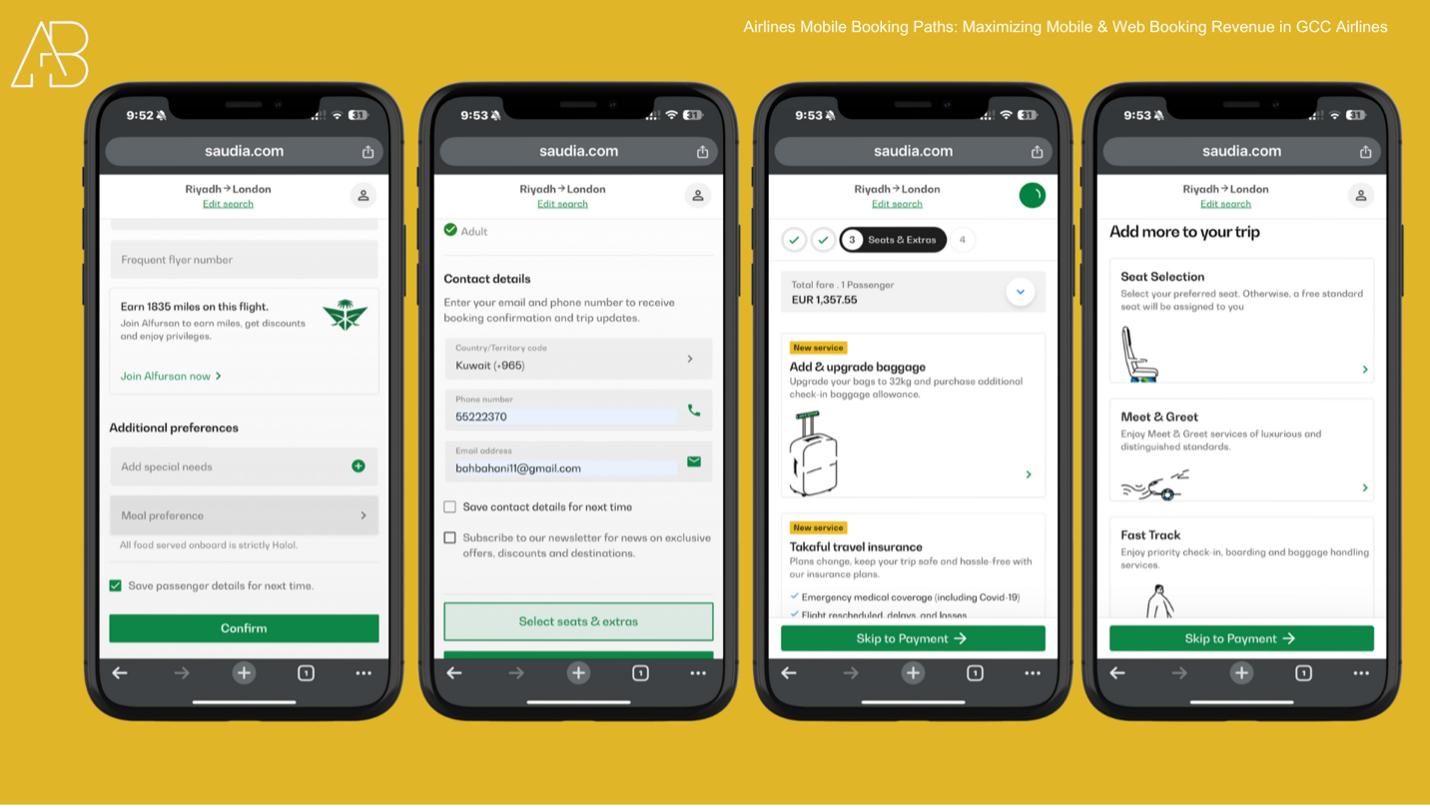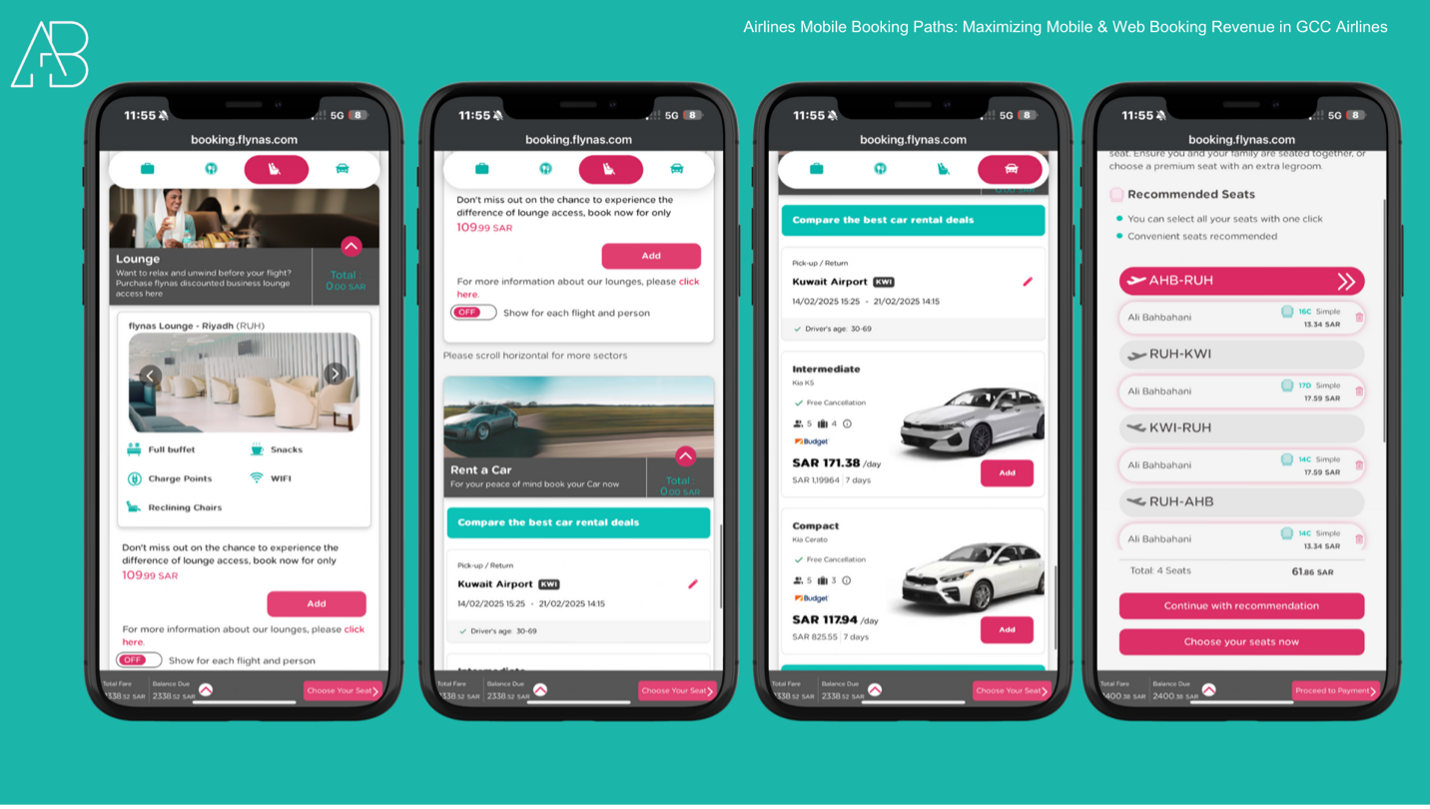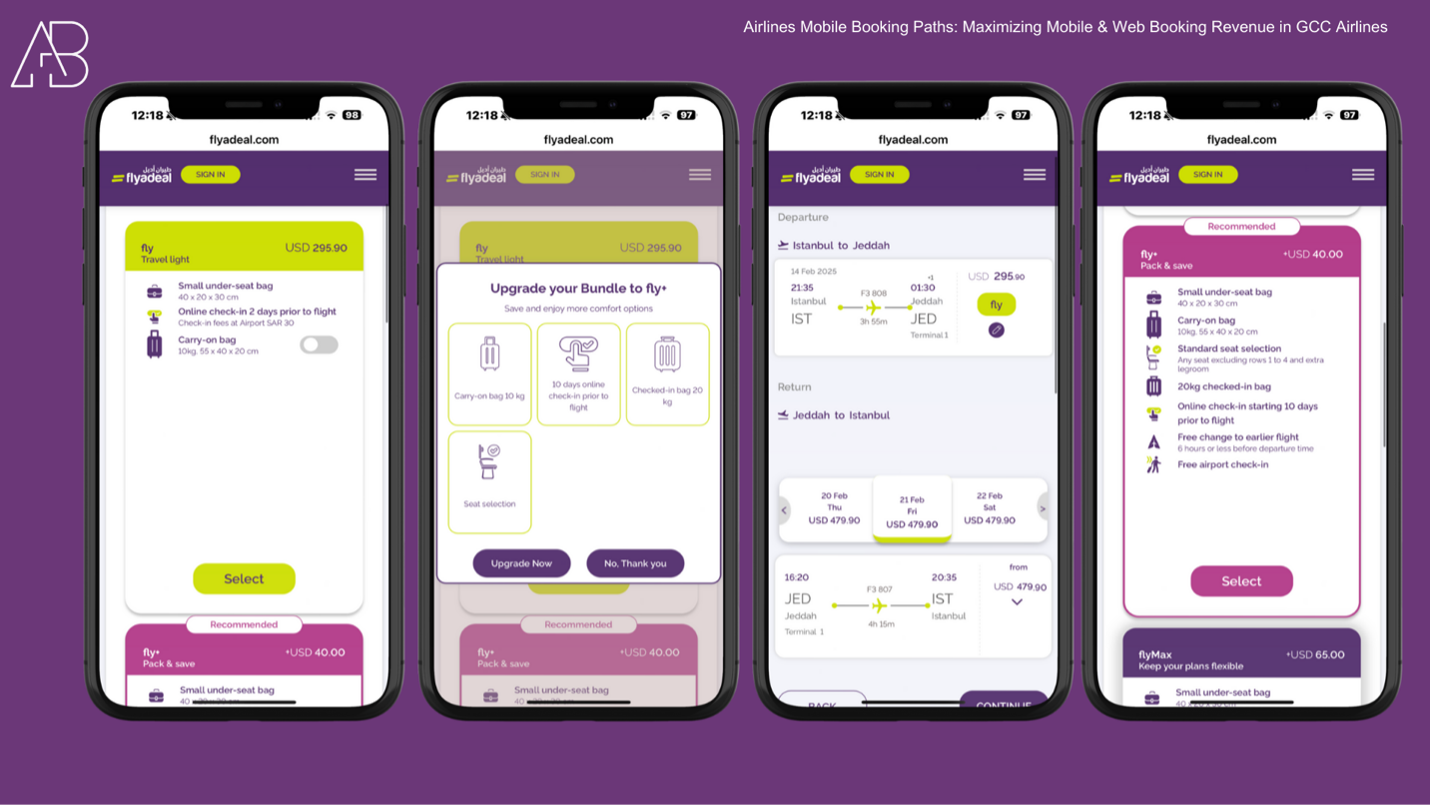Maximizing Mobile & Web Booking Revenue: A GCC Airlines Case Study
In the fast-evolving airline industry, maximizing mobile and web booking revenue is no longer optional; it’s essential. With soaring online booking abandonment rates and the growing dominance of mobile-first travellers, airlines must refine their digital booking experiences to convert lookers into bookers. This case study delves into the booking strategies of thirteen GCC airlines, analyzing their user experience, upselling tactics, loyalty integrations, and overall mobile responsiveness. By uncovering best practices and common pitfalls, we provide actionable insights to help airlines optimize their digital sales funnel, enhance ancillary revenue, and elevate customer engagement.
%20(3).png)
Introduction
Ever wondered why some airlines consistently convert lookers into booers, while others struggle with abandoned carts? Travel tech experts and airline strategists have been asking the same question. According to various studies, the answer often lies in two crucial areas:
1. Mobility: Over 7 billion mobile subscriptions worldwide mean travelers can (and do) browse flights anytime, while on break at work, waiting at a coffee shop, or even riding public transport.

2. Retail Responsiveness: The best “booking paths” actively respond to each traveler’s profile. That could mean prompting a family to add child meals, suggesting an upgrade to a premium seat for a business traveler, or offering a quick baggage bundle to someone who booked a basic fare.

Studies also show that booking abandonment rates can soar to 80% (or more) across e-commerce, including airline sites. Every extra click can cost you a chunk of those precious would-be customers. Meanwhile, airlines that master upselling, like seat selection, baggage, meals, insurance, or lounge access, can see ancillary revenues climb to 40–50% of their total intake.

This case study focuses on thirteen GCC and regional airlines and how they design (or could improve) their mobile booking flows. We reviewed each airline’s user experience, uncovering how they handle:
- Booking flow steps (from flight search to payment).
- Upselling for seat selection, baggage, meals, or even special stopovers.
- Loyalty prompts and data collection for email engagement.
- Responsive design.
As you read, ask yourself: Is my airline making the most of mobile? Are we tailoring the experience for families, solo travelers, or business flyers? Are we leaving revenue on the table by not prompting the right upsell at the right moment? Are we offering too many choices that would confuse the traveller?

Key Observations Across GCC Airlines
Before we drill down into each airline, here are four common threads we noticed:
1. Booking Flow & Steps
- Most carriers aim for 5–7 screens (or clicks). Low-cost carriers (flynas, SalamAir, flyadeal) often have slightly more steps to showcase multiple ancillaries. Full-service carriers (Qatar Airways, Emirates, Etihad) keep the flow tight, around 5–6 screens, while embedding premium cross-sells (like Doha Stopover or Chauffeur Drive).

2. Upselling Techniques
- Color-Coded Fare Bundles (Basic, Flex, Premium) help travelers quickly see seat or baggage choices (common in flyadeal, Jazeera Airways).
- Dynamic Pricing or in-path upgrades (like easyJet’s “seat map upsell”) aren’t always adopted fully, though Qatar Airways offers seat discounts to loyalty members.
- Extras such as hotels, tours, or stopovers are more common in premium carriers.
3. Loyalty Membership & Email Engagement
- Full-service airlines (Qatar, Emirates, Etihad, Saudia) display loyalty programs right in the booking flow, showing potential miles or offering partial redemption for flights.
- Some LCCs (flydubai, flynas) also mention loyalty, but not as aggressively. Others (like SalamAir or Jazeera) keep it minimal.
- Saudia and flynas impress with email reminders if a booking is abandoned, which can recapture 10–15% of lost sales.
4. Responsive Retailing & UI/UX
- A few carriers (like flydubai, Emirates) allow travelers to hold fares for a small fee, boosting conversions from hesitant bookers.
- Multiple pop-ups can overwhelm some users (as seen with SalamAir or flynas baggage/meal screens). Consolidating add-ons on one screen often proves more efficient.
- Seat maps remain a powerful upsell moment, yet many carriers miss easyJet’s approach of offering a second chance to upgrade once a traveler chooses a premium seat.
Now, let’s see how each airline stacks up.




1. Air Arabia
Flow & Steps
- Usually 5–6 steps to complete a booking. Clean and straightforward.
Upselling & Add-Ons
- Fare Families: Basic, Value, Ultimate.
- Clear fare breakdowns but limited dynamic personalization.
Loyalty & Data
- No major frequent flyer program.
- Minimal data collection (name, email, contact).
UI/UX Observations
- Could benefit from a fare lock feature.
- May consider membership or loyalty integration to encourage repeat bookings.





2. Kuwait Airways
Flow & Steps
- 6–7 steps. A bit more screens than some competitors.
Upselling & Add-Ons
- “Just Upgrade” bid for business class.
- Seat selection fees, but no strong bundled ancillaries.
Loyalty & Data
- Oasis Club prompt is mild, could be more visible. No direct pop-up and mentioning of beneifts for members.
- Collects passport info, offers KNET payment for Kuwaiti market.
- No Apple Pay, Google Pay, or Paypal options as payments.
UI/UX Observations
- Seat selection feels cluttered. Consolidating seats + baggage might help.
- Missing a fare calendar for price-sensitive shoppers.






3. Qatar Airways
Flow & Steps
- About 5–6 steps. Allows date-grid for flexible dates.
Upselling & Add-Ons
- Seat upgrades, meat and great, lounge passes, extra baggage.
- Offers seat-fee discounts to Privilege Club members.
Loyalty & Data
- Privilege Club (Avios) integrated throughout booking.
- Gathers passport details for smooth check-in.
UI/UX Observations
- Could add more family-friendly perks (like child-meal prompts).
- Stopover feature is a great cross-sell model for other carriers to emulate.






4. Etihad Airways
Flow & Steps
- 7-8 main screens, with a minimalist look, mpore than other airlines though.
Upselling & Add-Ons
- Extra baggage, seat selection, “neighbor-free” seats, Abu Dhabi Stopover.
Loyalty & Data
- No mentioning of memebrship benefits.
- Accepts local wallets, credit cards, installments.
UI/UX Observations
- Lounge pass prompts are subtle.
- Could merge seat + baggage + lounge upsells into fewer steps.




5. Emirates
Flow & Steps
- Typically 5–6 pages. Shows a fare calendar for flexible searches.
Upselling & Add-Ons
- Seat upgrades, baggage, Chauffeur Drive, and Dubai stopovers.
- Insurance and tours also appear for relevant routes.
Loyalty & Data
- Skywards membership is not promoted.
- Various payment methods (Apple Pay, PayPal).
UI/UX Observations
- Their premium cross-sell strategy stands out.
- Might consider child-friendly seat or meal discounts, as seen in some LCC success stories.





6. Saudia
Flow & Steps
- About 7-8 screens. More than other airlines. Multiple fare families (Guest Basic, Guest Saver, etc.).
Upselling & Add-Ons
- Baggage, seat, Takaful insurance, and meet & greet add-ons.
- Emails sent if a booking is abandoned, great for re-engagement.
Loyalty & Data
- Al Fursan membership prompt.
- Local payment (SADAD) plus credit cards.
UI/UX Observations
- Pop-ups for baggage or insurance can be merged.
- Family seating policies exist but aren’t strongly highlighted.






7. Gulf Air
Flow & Steps
- 7-8 steps, longer than usual.
Upselling & Add-Ons
- Economy Light vs. Smart fares, seat selection, lounge, occasional tours.
Loyalty & Data
- No push for FalconFlyer.
- Collects standard passenger data which makes it quicker, multiple card payments.
UI/UX Observations
- Could unify seat + baggage upsells on a single page.
- Cross-selling hotels or local experiences might add value for certain travelers.





8. Oman Air
Flow & Steps
- 5–6 steps, with a premium brand presentation.
Upselling & Add-Ons
- Extra baggage, seat upgrades, Majan Lounge access, and insurance all in one page.
Loyalty & Data
- No Sindbad membership prompt.
- Payment via cards and some e-wallets. No apple Pay and Google Pay.
UI/UX Observations
- Adding a fare hold or partial membership discount could boost conversions.
- Family deals (kids’ meals, child seat freebies) would set them apart.







9. Jazeera Airways
Flow & Steps
- 8-9 steps: flight selection, passenger info, seat/baggage, multiple extras, payment.
Upselling & Add-Ons
- Essential, Flex, Flex Plus bundles.
- “Fare Lock” available for a small fee.
- Multiple upselling points, its too many.
Loyalty & Data
- No major frequent flyer program, promoting subsricption program at fare price display.
- Basic data fields.
UI/UX Observations
- Fare lock is a powerful feature that can reduce abandonment.
- Color-coded seat map upgrades could be taken further.





10. flydubai
Flow & Steps
- About 7-8 screens from flight search to payment.
Upselling & Add-Ons
- Lite, Value, Flex fares with seat selection, baggage, meals, insurance.
- “Hold My Fare” for 24 hours.
Loyalty & Data
- Skywards integration from Emirates.
- Apple/Google Pay, KNET, credit card acceptance.
UI/UX Observations
- Great synergy with Emirates for loyalty.
- Could unify baggage + seat + meal on one page to cut down steps.







11. Flynas
Flow & Steps
- 8-9 steps, bright branding that appeals to younger travelers. Longest path to booking.
Upselling & Add-Ons
- Light, Value, Plus, Premium fare families.
- Baggage increments, seat upgrades, meal pre-orders, lounge, car rental.
Loyalty & Data
- No membership prompt.
- Payment via Apple Pay, STCPay, credit cards.
- Emails if a booking is incomplete, solid retargeting.
UI/UX Observations
- Could group seat, meal, and baggage upsells on one screen.
- Might introdue child-meal approach for family bookings.
- Get rid of “I am not a robot prompt”.
- Reduce ancillary services.





12. SalamAir
Flow & Steps
- 7-8 steps, typical Low Cost Carrier approach.
Upselling & Add-Ons
- Fare families: Lite, Saver, Flexi. Each unbundled: baggage, seat, meals, lounge, check-in fee.
Loyalty & Data
- No membership push.
- Collects contact info, passport details.
UI/UX Observations
- Multiple pop-ups might overwhelm users. Combining them can reduce friction.
- A “family fare” bundle might differentiate SalamAir in the market.







13. Flyadeal
Flow & Steps
- Around 7-8 main screens, bold visuals.
Upselling & Add-Ons
- Bundles: fly, fly+, flyMax. Baggage, seat, meal add-ons.
- “Hold Fare” for 24 hours.
Loyalty & Data
- No large frequent flyer scheme.
- Basic data and local Saudi payment methods.
UI/UX Observations
- Introducing a membership “club” or subscription might drive repeat bookings.
Best Practices & Recommendations
What truly drives conversions? Research, both globally and in the GCC, points to the following:
- Combine Upsells on One Screen
- Instead of forcing travelers through multiple pop-ups for baggage, seats, and meals, offer a unified add-ons page. This cuts clicks and frustration.
- Dynamic, Family-Friendly Deals
- If the system sees children in the booking, offer child meals or waived child seat fees.
- Seat Map Magic
- EasyJet’s success shows that a seat map can be more than just seat selection. It can prompt a second upgrade or a fare bump to premium if a traveler chooses certain seats.
- Fare Holds and Email Reminders
- A small fare hold fee encourages commitment from uncertain buyers. Plus, sending “You left something in your cart” emails can reclaim up to 10–15% of abandoned bookings.
- Loyalty in the Flow
- If you have a valuable club or membership, present it at the decision point. “Join now to save 20% on baggage” can be more compelling than a random link to “Join Our Program.”
Conclusion
Travelers don’t just want a ticket. They want a tailoredexperience that recognizes whether they’re traveling alone, with family, or onbusiness. The standout airlines don’t settle for generic pop-ups. They look atwho’s booking, what they’ve selected, and where they might be interested in anupsell.
Our deep dive into thirteen GCC airlines shows steadyprogress in seat selection, baggage bundling, loyalty prompts, and emailfollow-ups. But there’s room to grow, particularly around child discounts, lesssteps, seat-map-based fare upgrades, or membership prompts.

How Ali Bahbahani & Partners Can Help
At Ali Bahbahani & Partners, we know that a smarter, more responsive booking path can unlock substantial ancillary revenue while delighting your customers and reducing booking abandonments. Let us help you:
- Streamline your UX: Reduce clicks, unify pop-ups, and make upsells feel natural.
- Personalize offers: Introduce child meals, seat upgrades, or loyalty discounts at the right time.
- Retarget abandoned carts: Recover lost bookings with strategic emails or limited-time offers.
- Elevate loyalty: Embed membership sign-ups in the flow, giving travelers a reason to join now.
Interested in transforming your airline’s booking experience? Contact us and let’s create a journey where every traveler feels like you’re anticipating their needs, turning first-time browsers into lifelong fans.

